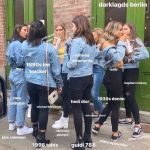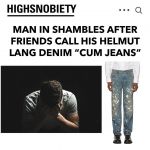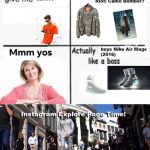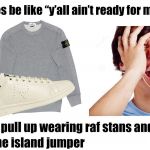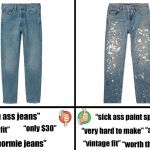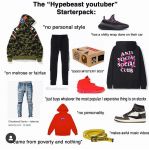
Inside the absurd and surreal world of fashion memes
The pages of fashion memes are the voice of the New Luxury
March 28th, 2020
Fashion doesn't make you laugh. Indeed, it could be said that the big luxury brands, while offering the public images of carefreeness and positivity, take themselves terribly seriously in their role. After all, behind each brand and its philosophy are investors, boards of directors and quarterly balance sheets to make ends meet. So if brands can't get unbalanced in irony, it's up to consumers to make humor. And in the age of social media, humor moves through memes. Pages such as @meme_saint_laurent, @geocasket, @raf_semens, @fuckhopsin and @cumdesgarcons count to date hundreds of thousands of followers and are distinguished both by the universe of references within which they move, mixing irony and information, and for the rich and detailed portrait they make, always in a parody key, of the same consumers of luxury fashion. In recent times, with the explosion of the secondhand market and the emergence of a new concept of luxury, these pages have carved out a space in the culture becoming poles of online aggregation and acting as light-hearted educational sources on the history of fashion.
One of the great (and perhaps unforeseen) merits of these pages is to put at their core not so much fashion manufacturers but consumers, exposing their neuroses and attitudes. There are as many parodies as there are the market segments: there are the depressed and misunderstood archival fashion fanatics, the partisans of Travis Scott's merch who blindly love their idol, the "Flower Boys" covered with Golf Wang from head to toe and the classic hypebeast with only the resell in mind. Each of these characters has their own recurring gags and jokes, but it should be noted that no group is excluded from this humor. In other words, anyone who is passionate about fashion can recognize themselves or their friends in them and see their traits mocked, but also celebrated, without any of the targeted categories being truly excluded.
In this sense, the fashion memes of these pages create a common language for all members of the community, avoiding flattening them all into a single stereotype and making them recognizable to each other. A common language and reference system inevitably strengthens the community's sense of identity. This community is one of the purest expressions of the New Luxury, whose consumers are hyperaware of the history of brands, able to understand the layers of irony hidden in a meme. The old luxury, on the other hand, was completely devoid of this self-irony that, in the case of fashion memes, tends to focus more on brands that took off in the 90s, such as Raf Simons and Rick Owens, and not on the most historical names in the industry, too institutional to be fertile ground to the desecrating humor of memes.
The humor of these pages, however, is based not only on the parody of the fashion addicts that you see online but also a kind of "informative" humor that hides in the midst of memes small lessons in fashion history. But they are never spies or story summaries about the most popular brands, but more to ultra-specialist references to individual items and collections or to avant-garde fashion designers. Comedy comes from the obscurity of reference – a real nerd comedy that mixes culture and parodies culture. The more a reference is abstruse and specialized (the protagonist of many gags is the now mythological "Riot Riot Riot Camo Bomber" by Raf Simons FW01), the more accentuated his bizarre and surreal traits.
This second strand of humor, which therefore makes fun of the supposed exclusivity of avant-garde fashion, however, has the merit of also acting as an information or cue for those who experience it for the first time. This is how these pages spread fashion culture in their own way and have created a real cult of fashion designers absolutely unre commercial but from fascinating stories like Carol Christian Poell or Boris Bjdian Saberi or have shed a light on moments pre-Instagram fashion landmarks such as raf Simons' first collections and Hedi Slimane's Dior era.
In addition to strengthening the sense of identity and belonging of the online community and playing an information role, these pages represent a lucid but light-hearted reflection of that large slice of consumers who know and appreciate the fashion of the secondhand market. It is a world composed mainly of young people and that at the moment is not really legitimized nor represented by fashion publications that focus instead on the primary fashion market. What should be noted, net of all the sarcasm and irony, is the constructiveness of the fashion discourse carried out by these pages, capable of self-moderating the rhetoric within the community by reflecting on the absurd and contradictory aspects of fashion but at the celebrating its positives, creativity and craftsmanship.






























































